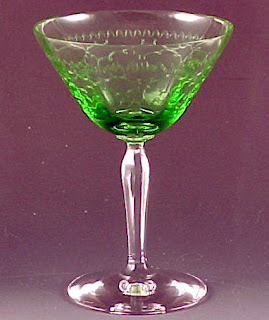
Recently I got a large set of Dogwood by MacBeth Evans from an antique dealer. This is pink, thin glass with a design of large four-petaled flowers and leaves. It’s quite pretty. I thought long and hard about buying all this, as you can imagine, because it was expensive and because this came from the ex-dealer. After all, she couldn’t sell it, so why would I? Anyway, I took the plunge and now have a nice set of Dogwood.

The valuable pieces in almost any depression pattern are the cereal and soup bowls, tumblers and some serving pieces. I got the cereal bowls, larger serving bowl, and best of all, four tumblers! Dogwood sherbets are scarce and we got some of them too. The cereal bowl and sherbet are shown in the photos.
MacBeth Evans made Dogwood in pink and green from 1929 to 1932, so it is one of the earliest depression glass patterns. Sometimes people call this Apple Blossom or Wild Rose because of the open flowers with wide petals, but this design has four petals, not five as would an apple or rose blossom. Dogwood is mold-etched, which means the design was etched into the mold and not into the glass. This method allowed glass companies to mass produce fanciful designs with intricate patterns quickly and with no hand work. Dogwood looks a little like the gorgeous brocade etches with its all-over pattern.
MacBeth Evans is the same glass company which made American Sweetheart and Petalware. Dogwood may be slightly less well-known than American Sweetheart, but it shares the same thin glass, pretty shapes and beautiful design.
 Fostoria's Coronet is one of their less-well known patterns, which is hard to understand since it is far more classy and elegant than some of their best known patterns. Coronet has the three wavy lines that you can see in our ice bucket and many of the pieces have scalloped rims.
Fostoria's Coronet is one of their less-well known patterns, which is hard to understand since it is far more classy and elegant than some of their best known patterns. Coronet has the three wavy lines that you can see in our ice bucket and many of the pieces have scalloped rims. 






































